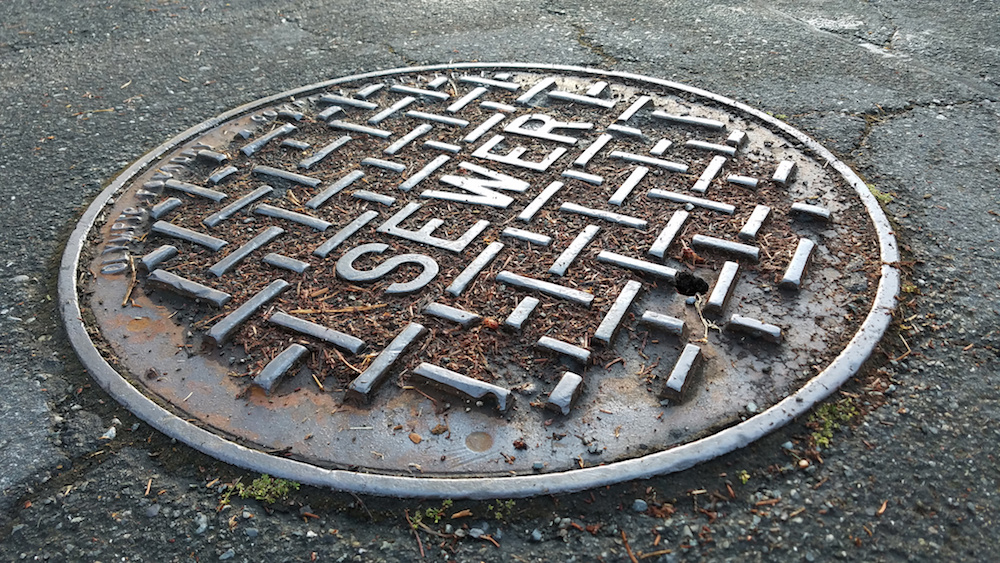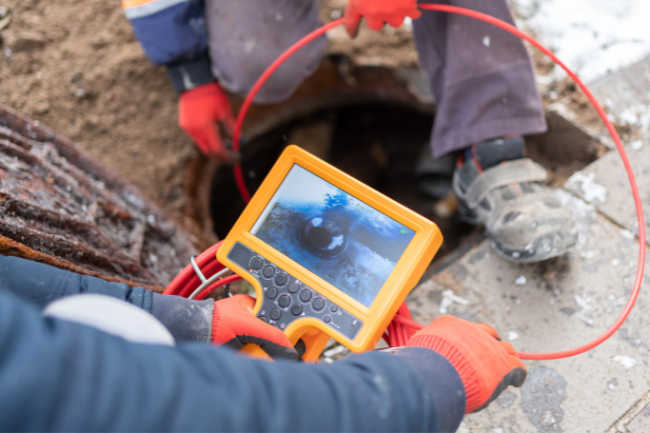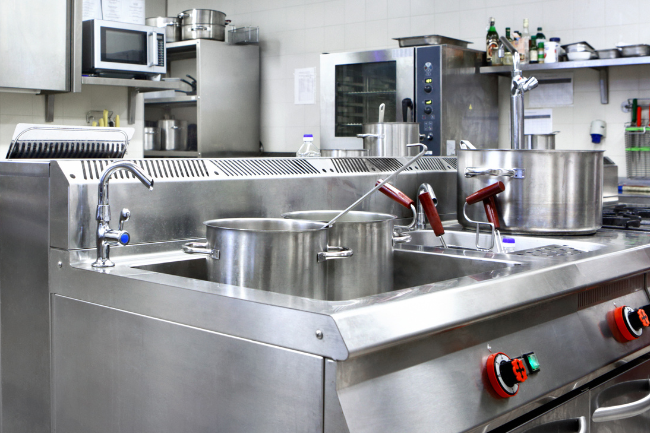6 Signs Your Dishwasher is Clogged and How to Fix Dishwasher Problems
Posted by Express Sewer & Drain Team on
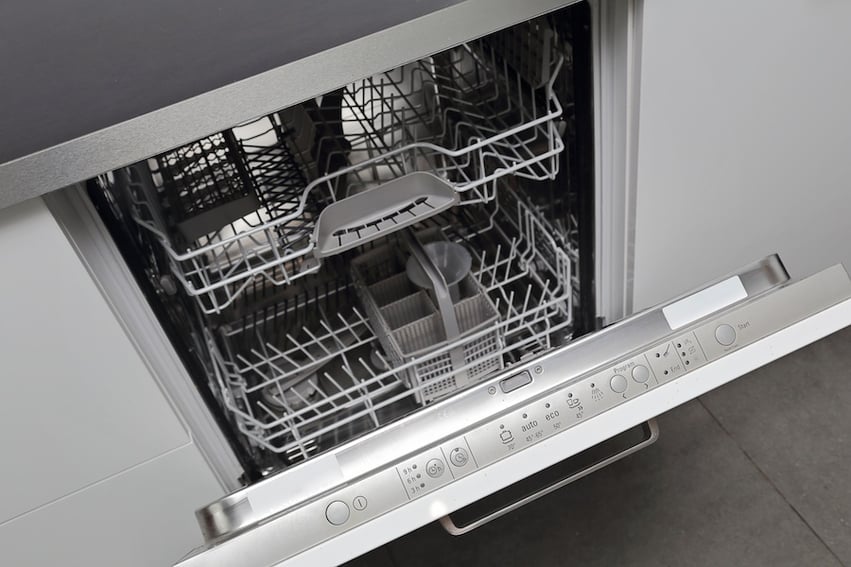
Dishwashers have become a major convenience in our lives. We load up the day’s dishes, run a cleaning cycle, and spend the next hour completing other tasks. It’s so easy, we often take having a dishwasher for granted – until it suddenly isn’t working.
The food particles and other items that collect in your dishwasher over time can create clogs and cause backups that limit performance. In this blog, you’ll learn about the key indicators of dishwasher problems that may indicate a clog. We’ll also look at how you can perform dishwasher repair on your own – and when it’s time to call in a professional.
Why Use a Dishwasher, Anyhow? I Can Wash Dishes By Hand!
If your dishwasher breaks down, it’s easy to forgo costly dishwasher repair and simply hand wash and dry dishes. But here’s the rub: Washing dishes by hand consumes 4-5 times more water than dishwashers and that adds up on your utility bill.
Of course, there was a time when dishwashers used a lot more water. But now, the Department of Energy regulates the amount of water modern dishwashers can use. So, if your dishwasher was manufactured after 2013, five gallons of water is its limit. On the other hand, the US Geological Survey estimates that it takes anywhere from 9 to 27 gallons of water to hand-wash a load of dishes.
6 Signs Your Dishwasher Problems Are Caused By a Clog
Think your dishwasher is clogged? Here are six tell-tale signs that indicate a dishwasher problem or clog.
1. You Hear Gurgling Sounds
Abnormal gurgling sounds, shaking, or thumping sounds while your dishwasher runs could indicate that there is water trying to break through a clog in your main or secondary sewer line.
2. Your Dishwasher Is Backing Up Water in Your Sink
Your dishwasher is connected to the drainage system in your kitchen sink. If your dishwasher is running and water begins backing up into your sink, it's possible your dishwasher has a clog.
You can rule out a dishwasher clog if you run your garbage disposal while the dishwasher is off. It's possible that the culprit is food that is caught in the sink, which means there are no problems with your dishwasher.
3. You Notice Slow Draining In Your Dishwasher
There may be a clog or a partial clog in your kitchen sewer line if you notice water pooling in the bottom of your dishwasher or in your sink. Clear out the partial clog as soon as possible so it doesn't become a more costly problem.
4. You See Water Backup In the Dishwasher After the Cycle.
Standing water in your dishwasher after a wash cycle means that your dishwasher isn't draining properly. This is because leftover food is clogging the drainage system.
Inspect your dishwasher, and clean the drain basket. If this doesn't take care of the problem, you may have a clog in your drains.
5. Your Dishes Are Not Cleaned
It's possible the dishwasher isn't filling with water if your dishes are still dirty after your wash cycle is complete. This is caused by a clog in your main or secondary sewer line.
6. Your Dishwasher Smells
If there’s a bad odor emanating from your dishwasher, a clogged filter basket is often to blame. The filter screens out larger food particles so they don’t clog the drain. Without regular cleanings, these particles will build up and break down, causing odors and potentially clogging the drain.
6 Reasons Your Dishwasher May Be Clogged
Here are five potential reasons you're experiencing a dishwasher clog.
1. Clogged Filter Basket
Your dishwasher has a filter basket fitted in the drain that prevents scraps of food and other items from entering the pipes. The filter basket needs to be cleaned regularly so that your dishes come out sparkling clean.
If you have hard water issues, you may need to soak the drain basket in a little vinegar to remove the deposits. This prevents the holes in your dishwasher filter basket from becoming clogged.
2. Clogged Drain Hose
Your dishwasher drains through a hose that can be connected to your kitchen sink drain or garbage disposal. The drain hose can get an interior build-up of sludge that causes backups and clogs.
Cleaning the dishwasher drain pipe and the other drain pipes under your sink will eliminate the clog if they are the source of your drainage issues.
3. Garbage Disposal
New garbage disposal installations can cause your dishwasher to become clogged if the knockout plug was not removed when the disposal was installed. Removing this plug will likely solve your dishwasher clogging issue.
If your garbage disposal is older, the things you've been putting down the disposal may be the source of your problem.
4. Clogged Drains
Your dishwasher may not be draining properly if there is a clogged drain further down the sewer line. However, if you have more than one clogged drain in your home or if water is gurgling back up into the sink when your dishwasher drains, you may have a more serious clog that has nothing to do with your dishwasher.
5. Clogged Spray Bars
Sometimes, unclean dishes can be the result of your spray bars, or spray arms, becoming clogged with food particles. Both the upper and lower spray bars are prone to collecting, and trapping, food particles.
6. Broken Sewer Line
Most people don't think that a clogged dishwasher can be caused by a broken sewer line. But a broken sewer pipe could block all of the drains in your home. If the dishwasher, guest toilet, and shower will not drain, it's time for a professional assessment of your home or business sewer pipes.
How to Unclog Your Dishwasher
Once you confirm that you have a clogged dishwasher, you can get started on trying to fix the issue on your own. We’ll take you through the process and highlight the dishwasher parts you’ll need to check.
1. Familiarize Yourself with Dishwasher Parts
Most often, dishwasher clogs are caused by improper use. For instance, some dishwasher owners aren't making sure they dispose of food and cooking oils properly, which causes fragments and oils to become lodged within dishwasher drain pipes.
Before you diagnose the problem, however, get to know your dishwasher. The diagram below will familiarize you with some dishwasher parts we'll be discussing shortly.
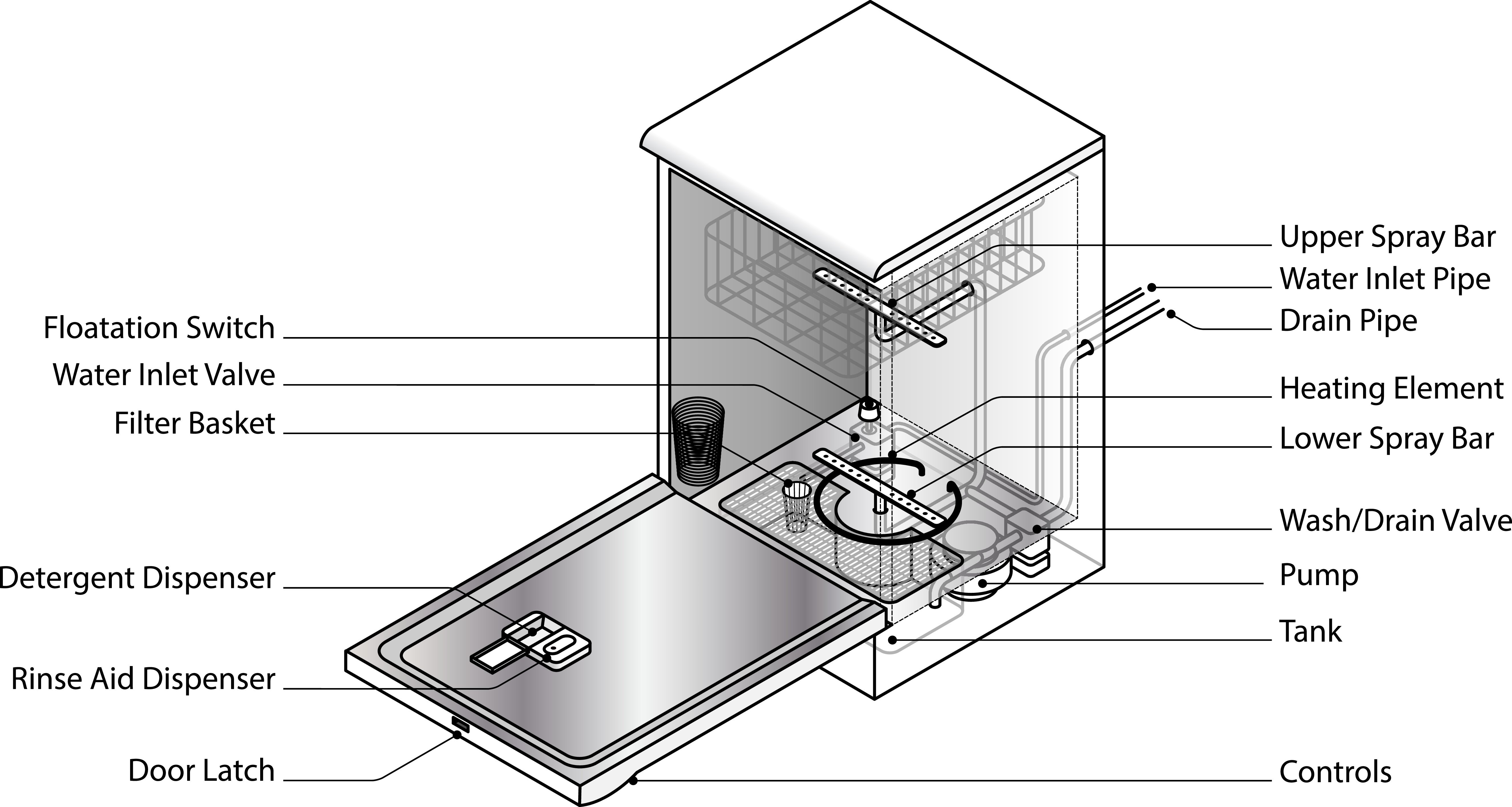
2. Gather the Right Plumbing Tools for the Job
Once you’ve properly identified the cause of your dishwasher clog, make sure you’re well-equipped to unclog your drains. Some essential tools you may need include:
- Drain snake or auger
- Phillips head screwdriver
- Pliers
- Bucket or towels
- Baking soda and vinegar
- Gloves
3. Check and Clean the Dishwasher Drain
Make sure your dishwasher unit is off or unplugged so you can stay safe during your DIY home plumbing project.
- Start by removing dish racks from your unit and then locate the drain grate. This is located at the bottom of your unit, or the "floor" of the dishwasher. The grate can be removed with a conventional screwdriver.
- Use a drain auger or a homemade flush to clear debris within the pipe. The flush should be a natural solution made of equal parts baking soda and vinegar (caustic chemicals can actually harm your drains more than help them). Then reattach the grate.
- Pour the remaining mix into the bottom of the dishwasher and let it sit for 15 minutes.
- Power your dishwasher back on, and run a rinse cycle at the highest heat setting.
- If the performance issues are resolved, replace the racks – you’re back in business!
4. Check and Clean the Dishwasher Filter
If dishwasher drain cleaning didn’t do the trick, check the appliance's filter. If you can’t locate it, check your owner’s manual or look up your make and model online (if you can’t find it, your appliance may not even have one).
- Once you’ve located the dishwasher filter, remove it by turning it clockwise until it releases.
- Remove this upper filter to gain access to the larger filter beneath it.
- Clear any debris you find in the filter.
- Replace the top filter and then turn it counterclockwise to secure it.
- Give the sprayer arm a gentle spin to be sure you’ve replaced the filter correctly (if the arm hits the filter, it’s not secured properly and could get damaged in a wash cycle).
- Run a rinse cycle on the hottest setting to see if the problem has been resolved.
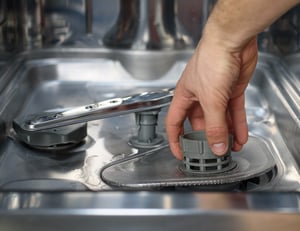
5. Check and Clean Your Sink’s Air Gap
Don’t have a garbage disposal? Check your sink’s air gap, which prevents drain water from the sink from backing up into the dishwasher. The air gap is a small, slotted cylinder that typically juts up near the faucet, though some may be below the sink near the dishwasher outlet hose. Take the following steps:
- Remove the sink gap by turning it counterclockwise.
- Clean out any debris with a stiff brush.
- Replace the cleaned-out sink gap and try running the dishwasher again.
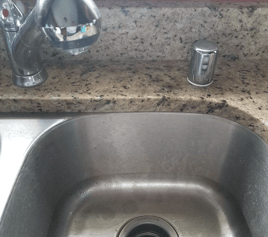
6. Check and Clean the Spray Bars
Spray bars can trap food particles, blocking the holes which spray water during the cycle. Spray bars can easily be removed and you can blast water from your sink through them to try to dislodge the particles or poke something through the holes. Hard water can also stop the flow of water from spray bars; soaking them in vinegar will help break up mineral deposits.
7. Check and Clean the Drain Hose
Still having dishwasher performance issues? The problem may lie with your drain hose. The hose is likely located in the back of the dishwasher so you’ll need to pull it away from the wall to get at it. You may also need to remove a plate located on the back of the dishwasher units to access the hose. Be sure the unit is powered off or unplugged before you get to work. Then, once you have access, do the following:
- Check for any kinks or bends in the hose that could be stopping it from draining properly.
- If that’s not the issue, grab your pliers and loosen the clamp on the hose so that you can remove the hose and visually examine it for any clogs. Be sure to have towels handy or a bucket to collect any water that is released.
- If you don’t see a clog, try flushing the hose with hot water to see if the water is flowing properly.
- If water isn’t flowing properly, use your homemade formula of baking soda and vinegar to try to flush out debris.
- You can also replace the hose if you can’t break up the clog. Remember to maintain the high rise loop as this provides proper flow.
- Reattach with the clamp and run a rinse cycle on the hottest setting to see if the problem is resolved.
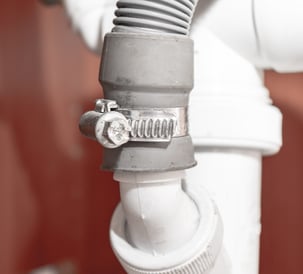
Dishwasher Problems Require Professional Help?
Blocked drains in a home can become a nuisance and a health risk. Business environments may even be required to shut down because of a clogged dishwasher and flooded floor if it is not addressed immediately. While DIY plumbing projects are a great way to save money, some dishwasher clogs require a professional. If you don't have the right tools to fix the dishwasher problem, or if you believe performance issues with your dishwasher unit are due to a more complex issue than clogging, contact Express Sewer & Drain.
At Express Sewer & Drain, we use high-grade video inspection tools to diagnose the problem. Our Sacramento plumbing experts can determine the exact cause of drain damage in your home. Then, they will identify the most practical and affordable dishwasher repair option for your plumbing issues.
Topics: Commercial Plumbing, Home Plumbing, Drain Cleaning and Repair

